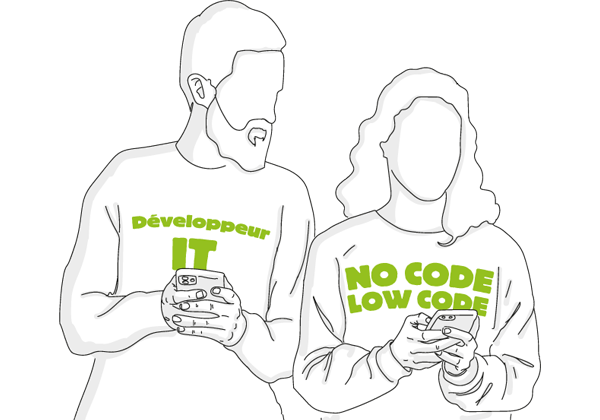Why turn to citizen development with SAP?
In a context where there is often a lack of IT manpower, time or means to design and publish business applications. The difficulty lies in correctly meeting business needs that are often poorly defined and/or misunderstood. We often hear of terms such as citizen developer and Low-Code/No-Code solutions as being the providential answer. But what can we really do with all this?
What is citizen development?
It’s a concept that affects any company that owns or wishes to automate, centralize or standardize processes (or validation flows) that can be translated into IT tools.
The concept behind it is that every player in a company (citizen) can become a developer. Without having to change jobs or take on new responsibilities. This means being able to :
- Express a need
- Design a solution
- Publish an application
The citizen developer responds to his own needs without having to rely on special knowledge or skills in development and programming;
To do this, the citizen developer can use intuitive and simple (not simplistic) tools, such as Low-Code / No-Code tools: with just a few clicks and manipulation, anyone can publish the application that meets their needs.
Low code, no code: what’s in it for the business?
In reality, while some may perceive this as an additional burden on their day-to-day work, this ” burden ” could well save time on several levels.
Low-Code / No-Code solutions give the business the ability to deliver an application, process or support that matches their vision.
This eliminates the need for the business to draft a requirement, which is often difficult to express in written IT terms, and which will then be interpreted by the IT department or any other person in charge.
The first advantage is therefore a solution that not only enables greater responsiveness, but also avoids the need for numerous preliminary exchanges designed solely to ensure that all parties involved are able to express and understand a requirement.
The intuitive and straightforward nature of the application is also there to guide the user and prevent cumbersome development, a source of errors and corrections.
The citizen developer understands and masters his application, and if a modification is necessary, he can react the instant the need is expressed.
The role of the IT department is changing:
- It becomes a coach for the businesses.
- It takes over tool maintenance.
- It takes on the role of creating incentives, generating a buzz around the use of its tools that is accessible to all, and thus promoting cohesion within the company.
Citizen development in the SAP ecosystem
In February 2021 SAP acquires AppGyver, a mainstay in Low-Code / No-Code development. The solution was then integrated into the BTP offerings and renamed SAP build Apps. Combined with other services, such as SAP Build Process Automation, SAP offers users guidance on the path to citizen development, and provides support for tasks carried out on the bangs of its initial product.
A simple example of a citizen developer in a company.
The need: My company regularly generates new products. In order to enter all the product characteristics required for its creation into SAP, and to be able to put it on sale, I need to centralize the data from various company players, and have them validated throughout the process before final entry. Data is entered and modified using an Excel file, and confirmations are made by sending an e-mail to the managers whenever necessary.
The usual practice is then to ask the IT department to develop an application to ensure more precise monitoring or even automation of the various stages.
As a citizen developer, you can use SAP Build Apps to generate an application that enables you to :
- Enter initial data,
- Perform preliminary checks
- Start process
With SAP Build Process Automation, the citizen developer can:
- Automate file creation with all validations.
- Generate a flow triggered by the application.
- Generate different forms requesting the input of information to complete the data collection or simply validation.
- Create the necessary rules to be applied so that forms and validations are sent to the right users without my having to intervene.
Finally, still with SAP Build Process Automation, it is possible to determine the format in which to recover all the information collected and validated.
In the end, the citizen developer :
- Gains autonomy,
- No need for a developer,
- Contact the IT department for a check-up when the applications are published, and the process that meets the need is already ready for use.
For the IT department, this trend means empowering SAP super-users in app development (and getting rid of unavailable and costly developers).

